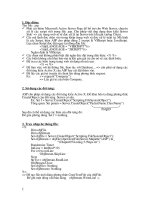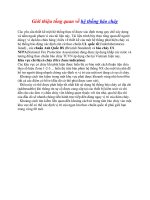Giới thiệu tổng quan về multicast
Bạn đang xem bản rút gọn của tài liệu. Xem và tải ngay bản đầy đủ của tài liệu tại đây (601.73 KB, 39 trang )
Multicast
1
Spencer Tsai
Mobile Communication & Broadband Network Lab
CSIE
Fu-Jen Catholic University
Introduction to Multicast
Multicast
2
Outline
•
Overview
•
IGMP
•
Multicast Routing on the Internet
•
Multicast Routing between Domains
•
Reference
Multicast
3
Overview
•
Unicast
•
Multicast
•
Multicast Characteristic
•
IP Multicast Address
•
Examples of permanent groups
•
Architecture of Multicast
Multicast
4
Unicast
Host
Router
. Point to point
. N receivers, send n times
. Not suitable for group communication
Receiver
Multicast
5
Multicast
Host
Router
. 1 sender and n receivers
. N receivers, only send 1 times
. Suitable for group communication
Receiver
Multicast
6
Benefits of Multicast
•
Saves bandwidth by enhancing network
efficiency in distribution of data
•
Group communication and services
•
Supports distributed applications
–
distance learning
–
videoconferencing
•
Reduces the cost to deploy applications
Multicast
7
Multicast Characteristic
•
RFC 1112
•
Each multicast group identified by class-
D IP address
•
Receivers can present anywhere
•
Receivers can join and leave anytime
•
Sender don’t need to be a member
•
No membership list exist, use routers to
manage groups
Multicast
8
IP Multicast Address
•
Multicast address range
Class D IP Address-higher order 4 bits are set
224.0.0.0 239.255.255.255
1 1 1 0
Multicast address
1 1 0
Net ID
8 16 24
32
IP system
1 0
Net ID
IP system
0
Net ID IP system
Class D
Class C
Class B
Class A
Multicast
9
Examples of permanent groups
All DVMRP routers in a subnet224.0.0.4
Not allocated224.0.0.3
Routers with RIP Version 2 in a
subnet
224.0.0.9
All routers in a subnet224.0.0.2
All systems in a subnet224.0.0.1
Reserved224.0.0.0
Multicast
10
Architecture of Multicast
Sender
Router
Receiver
IGMP
IGMP version 2
Multicast Routing
Multicast
11
Outline
•
Overview
•
IGMP
IGMP
•
Multicast Routing on the Internet
•
Multicast Routing between Domains
•
Reference
Multicast
12
IGMP
•
Internet Group Management Protocol (IGMP)
•
Group management within edge networks
•
RFC 1112 – IGMP version 1
•
RFC 2236 – IGMP version 2 (widely uesd)
•
Similar to the ICMP(Internet Control Message Protocol)
•
Router sends query to their directly hosts to manage group
membership
•
Different Hosts may join more than one multicast group
Multicast
13
IGMP – Join a Group
•
Joining members sends report
•
Different hosts can join different multicast group
Multicast Router
Host 1 Host 2 Host 3
224.2.2.3
ReportReport
224.2.2.2
Multicast
14
IGMP – General Query
Host 1 Host 2 Host 3
General query to
224.0.0.1
Multicast Router
•
Router periodically sends general query to
224.0.0.1(all systems in a subnet)
Multicast
15
IGMP – Maintaining a Group
suppress
Host 1 Host 2 Host 3
224.2.2.2224.2.2.2
Report
224.2.2.2
224.2.2.2
•
Two steps:
First, router sends general query
Second, member send report
•
Only one member needs to send report
Multicast Router
General query to
224.0.0.1
Multicast
16
IGMP – Leaving a Group
Host 1 Host 2 Host 3
General query to
224.0.0.1
Multicast Router
•
Router continue to send general query periodically
•
Members silently leave group
•
No report receive by router
•
Group times out
Multicast
17
IGMP - Querier Selection
Host 1 Host 2 Host 3
MRouter 1
1.1.1.1
MRouter 2
1.1.1.2
•
Initially, all routers are querier and send query
•
Then, only one router with the lowest IP address is
selected as the actual Querier
•
The other routers are Non-Querier
Multicast
18
Outline
•
Overview
•
IGMP
•
Multicast Routing on the Internet
Multicast Routing on the Internet
•
Multicast Routing between Domains
•
Reference
Multicast
19
Multicast Routing on the Internet
•
DVMRP
•
MOSPF
•
PIM-DM
•
PIM-SM
•
CBT
Multicast
20
DVMRP
•
Distance Vector Multicast Routing Protocol
(DVMRP)
•
Distance vector algorithm that determines the
shortest path (hop count)
•
Like RIP, maintains a routing table
•
Uses RPF(Reverse Path Forwarding)
–
The first data is flooded to the entire network
–
No members or terminating membership, do pruning
Multicast
21
DVMRP (cont.)
•
Graft is used to reconnect an old area or
connect a new area
–
Member to source
•
Graft ack. Indicates that a graft has been
received correctly
–
Source to member
•
Designated forwarder
–
First, lowest metric to a source
–
Second, lowest IP address
Multicast
22
MOSPF
•
Multicast Extensions to Open Shortest Path
First
•
OSPF
–
Hello
–
Synchronize database description
–
Link state advertisement
•
MOSPF
–
Local group membership must be known in the routers
–
A separate multicast tree has to be calculated for each
pair consisting of sender and group G(S,G)
Multicast
23
MOSPF (cont.)
Autonomous System
BR
BR
BR
R
Boundary AS
router
R
Domain
Domain
Domain
Backbone
AS
Multicast
24
PIM-DM
•
Protocol Independent Multicasting-
Dense Mode (PIM-DM)
•
Members are not widely distributed,
density of group member is very high
•
Uses flooding, pruning and graft
•
Similar to DVMRP
–
Without the routing information exchange part
–
Differs in some details
Multicast
25
PIM-DM (cont.)
Source
B
Receiver 1
C
A
D
E
Initial








